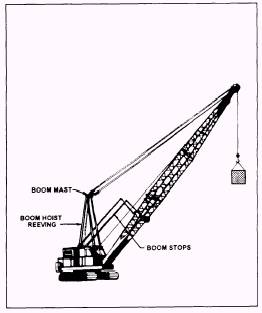|
Jib and Extension Figure 12-17 shows one type of jib and boom extension. A jib is an extension of a boom capable of being mounted on either a hydraulic or lattice boom. The jib is equipped with its own forestay pendant lines, connected from the jib tip to the jib mast. The jib mast is connected to the boom tip. The jib backstay pendant is normally manually adjustable to change the angle of the jib. On most cranes the function of the jib is to increase the lift height and to aid in increasing load radius. The operator's manual will have instructions on how to install a jib or extension. You must remember if lifts are made with the main hook block the weight of the jib assembly will reduce the lifting capacity of the crane; therefore, you must deduct the effective weight of the jib assembly from the gross capacity of the crane. Gantry The gantry, or A-frame, is a structural frame, extending above the revolving superstructure (fig. 12-18). The gantry supports the sheaves in which the

Figure 12-17.-Jib and boom extension mounted on a hydraulic boom.

Figure 12-18.-Gantry. boom hoist lines are reeved. The height of the gantry provides an angle between the boom pendant lines and boom that reduces the compression forces placed on the boom during raising and lifting operations. On some models of cranes, the gantry is adjustable, allowing it to be lowered so the crane can travel under wires and bridges. WARNING Refer to the operator's manual for instructions on how to raise and lower the gantry. A trial-and-error method of lowering or raising the gantry can cause serious injury or death. NOTE: Raising the boom while the gantry is in the lowered position lowers the angle between the pendants lines and boom. This places unseen compression stresses on the boom; therefore, always raise the gantry before raising the boom or lifting a load. Boom Mast Some models of cranes are equipped with a boom mast instead of a gantry. The boom mast, sometimes called live mast, consists of a structural frame hinged at or near the bottom of the boom butt (fig. 12-19).

Figure 12-19.-Boom mast. The tip of the boom mast supports the boom hoist sheaves and boom pendant lines. The boom mast works like the gantry, as it increases the angle between the boom pendants and boom, decreasing the compression forces placed on the boom.
|

